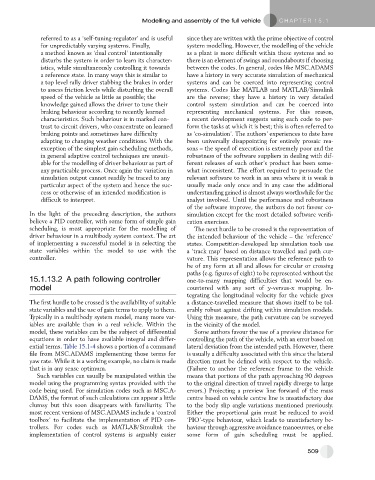Page 501 - Automotive Engineering Powertrain Chassis System and Vehicle Body
P. 501
Modelling and assembly of the full vehicle C HAPTER 15.1
referred to as a ‘self-tuning-regulator’ and is useful since they are written with the prime objective of control
for unpredictably varying systems. Finally, system modelling. However, the modelling of the vehicle
a method known as ‘dual control’ intentionally as a plant is more difficult within these systems and so
disturbs the system in order to learn its character- there is an element of swings and roundabouts if choosing
istics, while simultaneously controlling it towards between the codes. In general, codes like MSC.ADAMS
a reference state. In many ways this is similar to have a history in very accurate simulation of mechanical
a top level rally driver stabbing the brakes in order systems and can be coerced into representing control
to assess friction levels while disturbing the overall systems. Codes like MATLAB and MATLAB/Simulink
speed of the vehicle as little as possible; the are the reverse; they have a history in very detailed
knowledge gained allows the driver to tune their control system simulation and can be coerced into
braking behaviour according to recently learned representing mechanical systems. For this reason,
characteristics. Such behaviour is in marked con- a recent development suggests using each code to per-
trast to circuit drivers, who concentrate on learned form the tasks at which it is best; this is often referred to
braking points and sometimes have difficulty as ‘co-simulation’. The authors’ experiences to date have
adapting to changing weather conditions. With the been universally disappointing for entirely prosaic rea-
exception of the simplest gain scheduling methods, sons – the speed of execution is extremely poor and the
in general adaptive control techniques are unsuit- robustness of the software suppliers in dealing with dif-
able for the modelling of driver behaviour as part of ferent releases of each other’s product has been some-
any practicable process. Once again the variation in what inconsistent. The effort required to persuade the
simulation output cannot readily be traced to any relevant software to work in an area where it is weak is
particular aspect of the system and hence the suc- usually made only once and in any case the additional
cess or otherwise of an intended modification is understanding gained is almost always worthwhile for the
difficult to interpret. analyst involved. Until the performance and robustness
of the software improve, the authors do not favour co-
In the light of the preceding description, the authors simulation except for the most detailed software verifi-
believe a PID controller, with some form of simple gain cation exercises.
scheduling, is most appropriate for the modelling of The next hurdle to be crossed is the representation of
driver behaviour in a multibody system context. The art the intended behaviour of the vehicle – the ‘reference’
of implementing a successful model is in selecting the states. Competition-developed lap simulation tools use
state variables within the model to use with the a ‘track map’ based on distance travelled and path cur-
controller. vature. This representation allows the reference path to
be of any form at all and allows for circular or crossing
paths (e.g. figures of eight) to be represented without the
15.1.13.2 A path following controller one-to-many mapping difficulties that would be en-
model countered with any sort of y-versus-x mapping. In-
tegrating the longitudinal velocity for the vehicle gives
The first hurdle to be crossed is the availability of suitable a distance-travelled measure that shows itself to be tol-
state variables and the use of gain terms to apply to them. erably robust against drifting within simulation models.
Typically in a multibody system model, many more var- Using this measure, the path curvature can be surveyed
iables are available than in a real vehicle. Within the in the vicinity of the model.
model, these variables can be the subject of differential Some authors favour the use of a preview distance for
equations in order to have available integral and differ- controlling the path of the vehicle, with an error based on
ential terms. Table 15.1-4 shows a portion of a command lateral deviation from the intended path. However, there
file from MSC.ADAMS implementing those terms for is usually a difficulty associated with this since the lateral
yaw rate. While it is a working example, no claim is made direction must be defined with respect to the vehicle.
that is in any sense optimum. (Failure to anchor the reference frame to the vehicle
Such variables can usually be manipulated within the means that portions of the path approaching 90 degrees
model using the programming syntax provided with the to the original direction of travel rapidly diverge to large
code being used. For simulation codes such as MSC.A- errors.) Projecting a preview line forward of the mass
DAMS, the format of such calculations can appear a little centre based on vehicle centre line is unsatisfactory due
clumsy but this soon disappears with familiarity. The to the body slip angle variations mentioned previously.
most recent versions of MSC.ADAMS include a ‘control Either the proportional gain must be reduced to avoid
toolbox’ to facilitate the implementation of PID con- ‘PIO’-type behaviour, which leads to unsatisfactory be-
trollers. For codes such as MATLAB/Simulink the haviour through aggressive avoidance manoeuvres, or else
implementation of control systems is arguably easier some form of gain scheduling must be applied.
509

